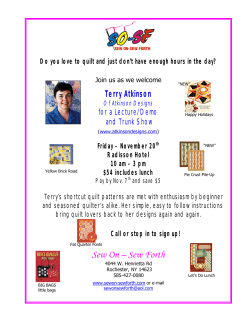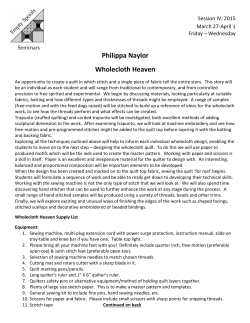
Marge Skreko showed how to make beautiful coordinated fabrics from
Marge Skreko from Rit Dye showed how to make beautiful coordinated fabrics from unmatched, unused fabrics with a quick over-dyeing process. AQC406 Over-Dye Your Fabrics Marge Skreko Over-Dye Your Fabrics M any times you have odd fabrics that are perfectly good, but that you just don’t like any more, or as Marge said, had “expired inspiration”. Pick a color scheme, and jump right in! Your results may not be quite what you expected, but they will be beautiful, and coordinated! Different colors come out different. For example, yellow fabric, dyed blue, turns green! Here are different “before and after” pieces. You can see the dramatic results! [Figures 1, 2 and 3] Basic information when purchasing different types of Rit Dye powdered or liquid: Sewing Supplies ✄ Pfaff creative 2144 Sewing and Embroidery Machine ✄ Rit Dye ✄ Sulky Tear Easy ✄ Rowenta Expert Iron ✄ Warm and Natural Batting ✄ Pfaff Creative Card 338, quilt Splendor #820148096 Rit Measurements: • One box powder = 2 TBL • 2 TBL powder = 1/2 cup liquid (4 oz.) • 1 liquid bottle (8 oz.) = 4 TBL powder You can dye samples to see what your results will be before you dye all your yardage. The following are the “recipes” to convert large quantities to small to dye your samples. Recipe 1 Figure 1 Sample dyeing prevents mistakes. Preview your results on a small sample, not on five yards of fabric. The dye quantities listed for sample dyeing convert into the amounts needed to dye one lb. of fabric (dry weight) a medium shade, in three gallons of 140°F water, with a timed dye bath duration of 30 minutes. If the color is too light, add more dye: two times to four times as much depending upon the shade desired while keeping all else the same. If the color is too dark, use less dye with all else remaining the same. Dyeing procedure to determine a color: Recipes are performed on a stove using one quart of hot water (60°F = 140° F) in a non-reactive container (stainless steel or enamel). Figure 2 A fat quarter and/or a swatch (small, representative piece) of the actual material can be used. All fabrics should be washed in detergent before dyeing to remove any factory finishes. Timed duration for the dyebath is 10 minutes. All item are rinsed in cool water until the water runs clear. A small amount (1/2 tsp.) of detergent can be added to the rinse water to help remove any unbonded dyes. Press sample fabrics between paper towels. If dye appears on the paper towel, more rinsing is needed. Pressing can continue until fabric is dry, or fabric can be line or machine dried. Figure 3 31 32 Over-Dye Your Fabrics Chapter title Sewing Supplies Frankie’s Quilt ✄ Pfaff creative 2144 Sewing and Embroidery Machine ✄ 5 fat quarters of coordinating print fabrics (or use up a variety of print scraps) ✄ 1/3 yard each of three coordinating solid fabrics ✄ 1/2 yard of coordinating fabric for binding ✄ 1-1/4 yard of coordinating fabric for backing ✄ Warm and Natural Cotton batting ✄ Sulky Tear Easy Stabilizer ✄ Schmetz Size 90 Topstitch Needle ✄ Sewing Thread ✄ Sulky 30 or 12 wt. Cotton thread for embroidery designs ✄ Pfaff #338 Quilt Splendor designs #820148096 ✄ Narrow Edge Foot w/IDT #820217096 ✄ 1/4 Inch Quilting Foot w/IDT #820211096 Approximate finished size of quilt 39” X 42” AQC406 TIP: Microwave setting: Fabric can also be dip-dyed and heat set in the microwave: • Dip fabric in dye solution mixed in one qt. quantities. • Place fabric in a plastic bag or wrap in plastic wrap upon removal from the dyebath and before rinsing. • Microwave on high for two minutes. • Follow rinse procedure. TIP: Fasten the dye recipe to a swatch of the dyed fabric and save for future reference. Liquid Dye to Powder Dye Conversions Converting sample dye quantities into amounts needed to dye one lb. dry weight: • 3 gallons 140°F water – 30 minutes dyebath duration LIQUID DYE Sample Amount to one lb. Measure 4 tsp = 1 cup 2 tsp = 1/2 cup 1 tsp = 1/4 cup 1/2 tsp = 2 TBL 1/4 tsp = 1 TBL 1/8 tsp = 1 1/2 tsp 1/16 tsp = 3/4 tsp POWDER DYE Sample Amount to one lb. Measure or or or or or or or 1/2 tsp = 4 TBL 1/4 tsp = 2 TBL 1/8 tsp = 1 TBL 1/16 tsp = 1 1/2 tsp 1/32 tsp = 3/4 tsp 1/64 tsp = 3/8 tsp 1/128 tsp = 1/4 tsp Once you have determined your chosen colors, dye the full yardages. Frankie Seme-Bunevich, Pfaff creative Consultant, made a quilt with the dyed fabrics. Here are the directions to make the quilt. [Figure 4] Take the three 1/3 yard pieces of solid fabrics and cut each piece into four even blocks. You should have twelve squares of solid fabric roughly 12” X 12”. We will square the blocks up later, after the embroidery is complete. Hoop Tear-Easy Stabilizer and a block of solid fabric and embroider one of the Quilt Splendor blocks design. Embroider a different design on each of the twelve blocks. When embroidery is complete, remove excess stabilizer from the back of the fabric and iron. Cut the blocks 8” wide and a variety of lengths ranging from 8” to 12” long, with the embroidery centered. The quilt is designed to have a scrappy look, so cutting a variety of lengths will add interest to your quilt. Cut the five fat quarter prints 8” wide and anywhere from 8” to 12” long. Some of the lengths will be determined by the fabric scraps. Have fun with the lengths. Next, lay out your quilt blocks in five columns, keeping the embroidered blocks towards the inside of the quilt so the design will not get cut off. Check that the total length of the quilt is longer than 42”. Try not to put the same Figure 4 AQC406 fabric or any of the future patchwork seams matching next to one another and just have fun. Snap on your 1/4 Inch Foot and thread with sewing thread top and bobbin. Using 1/4” seam allowance sew the blocks together, forming five strips roughly 42” in length or longer. Press all of your seam allowances to one side. Sew all of the strips together using your 1/4” seam allowance and press seams to one side. Remember the seams should not match, this is a scrappy quilt. Trim and square up the quilt top to 42” in length and roughly 38” wide. Over-Dye Your Fabrics backing fabric right side down, batting in the middle and quilt top right side up on top. Use the Narrow Edge Foot with IDT to quilt the top, following the seam lines. Square up the layers and bind the quilt with your favorite binding method. To learn to bind your quilt, see page 95. Cut a piece of Warm and Natural Cotton batting and backing fabric 1” larger than the quilt top. Safety pin the layers together with the QUILTING & TECHNOLOGY WITH HP Choose the Correct Fabric for your Project J oe had a number of different examples of the different types of fabric available to print on. The Gloss Finish Artist Canvas sheets from Vintage Workshop (#140001599) are perfect for a handbag, but would be way too stiff for a garment. An Iron-on Transfer from Vintage Workshop (#140001600) is perfect to transfer an image to a project that can’t go through the printer. You can transfer directly to the bag, garment or project. Cotton Canvas from Vintage Workshop (#140001598) is perfect for crafts projects and anything where a heavier, stiffer fabric is desirable. Silk on the other hand is ideal for scarves, blouse or vest panels or Home Dec projects where a soft, flowing fabric is desirable. Color Plus fabrics have silk available in 14mm weights and 23mm weights. • #140001086 Silk 14 mm 8.5” x 11” sheets • #140001087 Silk 14 mm roll 8.5” x 3 yards • #140001088 Silk 23 mm 8.5” x 11” sheets • #140001089 Silk 23 mm roll 8.5” x 3 yards Some other factors to look are the wash-ability factor, and wear and tear. Some of the heavier canvases will show wear at the folds for example, on a project that would be used a lot. A button on purse was a perfect solution to a bag where the image could be changed for the season or for different occasions. ■ 33 34 What’s New to Do! Blending Photos with Fabric M ary Ellen Kranz, teacher and co-author of Blending Photos with Fabric by The Electric Quilt Company, joined Karen, Sue and Andrea Poulimenos with ideas for blending photos into your quilts. Mary Ellen has sewn many of the beautiful samples that Andrea brings to America Quilts creatively to share with our viewers. Andrea wanted Karen and Sue wanted to meet her in person! In Mary Ellen’s book, you will experience a new way of using photographs in your quilts! Make personal photos appear as fabrics, rather than snapshots, by learning to blend photos with quilt fabrics. Create quilts that capture memories of your garden, your vacation — anything reflecting your fascinations, moods, and passions. Complete instructions for 10 quilts; 16 suggested variations are included. Mary Ellen uses printed photos in quilts in such a way that you can’t tell where the photo fabric you’ve created ends and the purchased fabric begins. It isn’t limited to just photos of family. You can use photos of just about anything! Handwriting, grass, flowers nothing is off limits for Mary Ellen. She will often take everyday photos of everyday things and print them. Try enlarging them and cropping out just one part, for example a flower pot. Then use the photos to choose fabric to coordinate. Everyday items that are special to you, like old postcards and maybe a stamp collection can be a quilt unto itself! [Figures A and B] Figure A Figure B 35 What’s New to Do! Mary Ellen scanned in vegetables, seed packets and even books to include, to all work into the vegetable garden theme. [Figure C] When you have the photos printed the way you want them on paper, then you are ready to print them on Electric Quilt Inkjet Fabric Sheets #140001434. You can then incorporate them into your favorite quilt design and have a truly one of-a-kind masterpiece! Figure C (group)
© Copyright 2025









